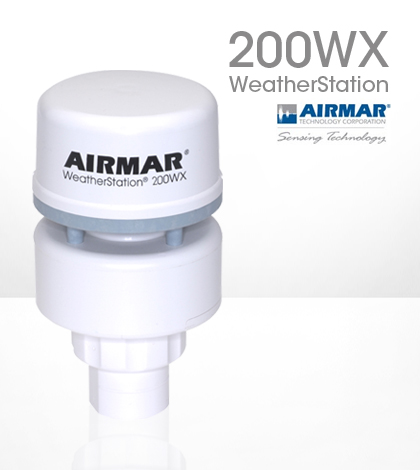Airmar WX Series WeatherStations prove flexible in the field

Airmar’s business model is built entirely around transducers, mainly for boating and environmental applications. That meant it was only natural to base the WX Series WeatherStations around four transducers.
“The weather station uses transducers to measure wind ultrasonically,” said Irene Robb, Airmar product manager.
The four transducers are paired to send ultrasonic sound waves back and forth. Wind passes through a horizontal gap in the weather sensor housing and pushes the sound waves around.
The WX Series measures wind speed and direction based on delays or accelerations in sound wave transmission. Robb said Airmar engineers designed them to operate at a low frequency to minimize interferences.
Other standard features of the WX Series include barometric pressure, air temperature and calculated wind chill.
The line’s high-end models, like the 150WX and 200WX, can measure both apparent wind speed and true wind speed. Most weather stations measure apparent wind speed, which is the speed of wind hitting the sensor at any given time.
True wind speed is calculated by the WX Series based on two other built-in sensors. The weather stations incorporate compass headings and GPS signals to determine if the sensor is moving. Then, it factors in apparent wind speed hitting the sensor. Together these factors give the sensor the ability to calculate wind speed while attached to a moving vehicle, a buoy or glider drifting in the ocean.
The WX Series wind sensors read wind speeds up to 90 miles per hour. Robb said Airmar engineers are working to build a transducer sensitive to nearly double that speed for monitoring extreme environments like hurricanes.
A recently upgraded optional feature for the WX weather stations is a serviceable humidity module. The module was developed after Airmar experienced issues with wear and corrosion in the previous generation of the WX Series. “We decided to find a way to put a humidity sensor in a module that can be replaced by a user,” Robb said.
New humidity modules can be field swapped or sent back to Airmar for recalibration. They are also better sealed from corrosive salt in marine environments. So far, Robb said, none of the new modules have come back for recalibration since their release two years ago.
WX Series WeatherStations communicate with data loggers and computers via RS232, RS422 or CAN BUS protocols. Customers can control data reporting frequencies for the stations, so they work in conjunction with the logging intervals of other sensors.
Each weather station is calibrated before leaving the Airmar factory. Two robots pitch and rotate the weather sensors to calibrate the WX Series’ optional compass and accelerometers. The factory also has two wind tunnel where every weather station is calibrated, simulating exposure to real-world conditions prior to customer deployment.
When it comes to installation of a WX Series, one must always be conscious of his or her surroundings. “You’ve got to keep in mind that it is a sensor and it only reads what it sees,” she said.
That’s why finding an optimal location for the station is critical. The main factor users have to account for is wind shear.
Boaters using the station may need to elevate it out of the way of air shearing over the top of the boat. Robb said buildings also create wind shear, which can make finding the best mounting location tricky. She said some trial or comparison to another sensor may be necessary to find the best location.
Airmar WX Series WeatherStations start around $585 for temperature, barometric pressure and apparent wind readings. Fully equipped 200WX WeatherStations, with optional compass, accelerometer, and humidity sensors go for about $1200.




0 comments